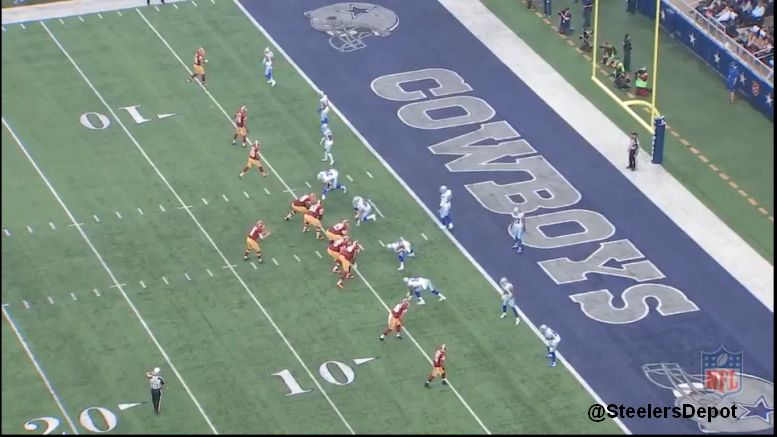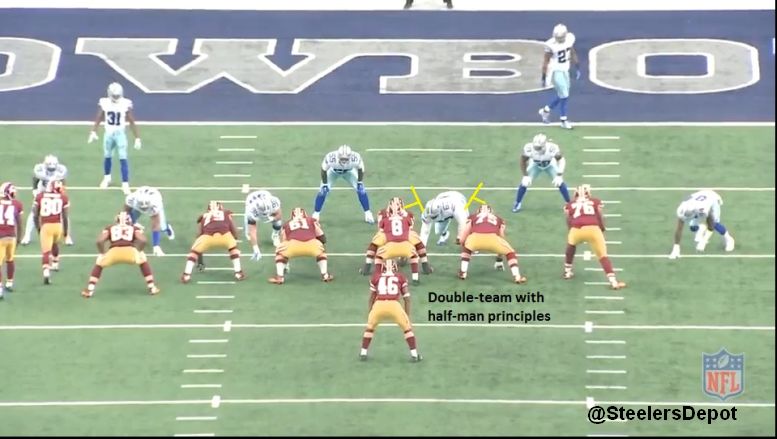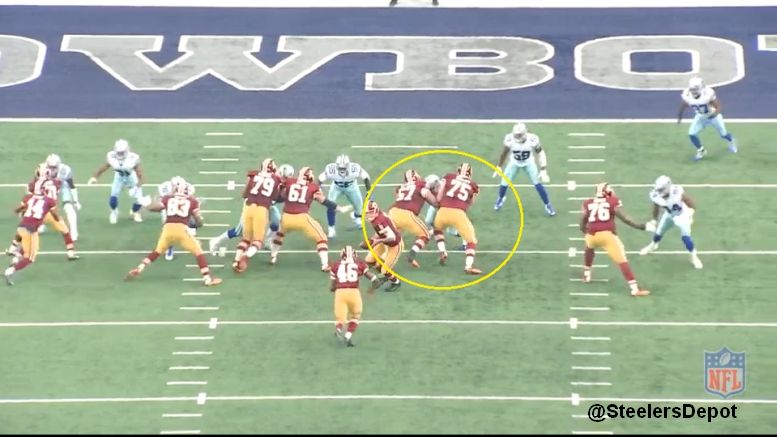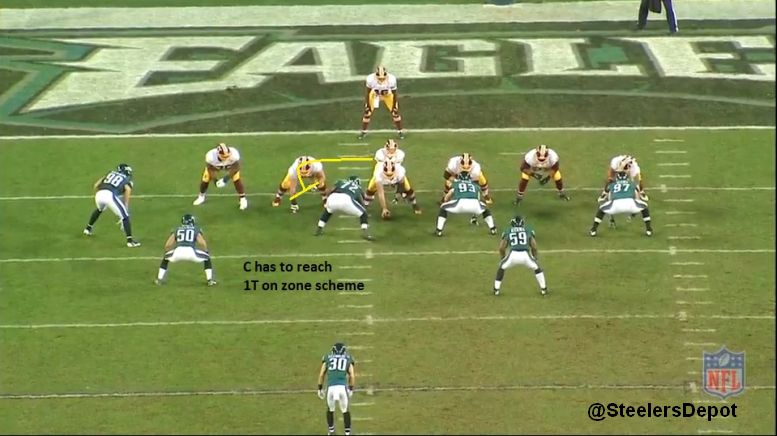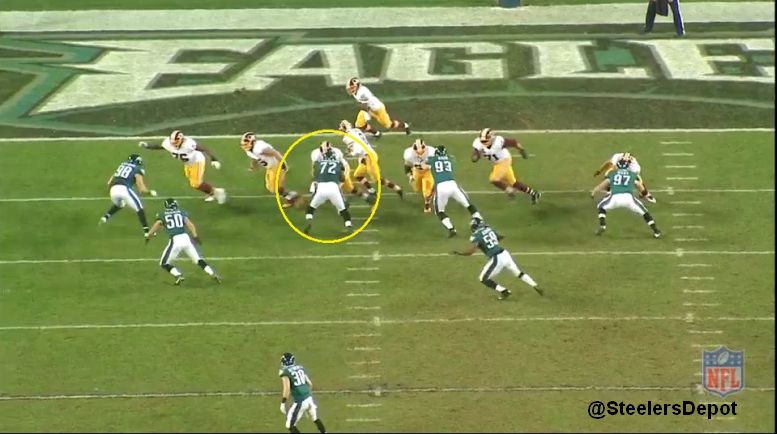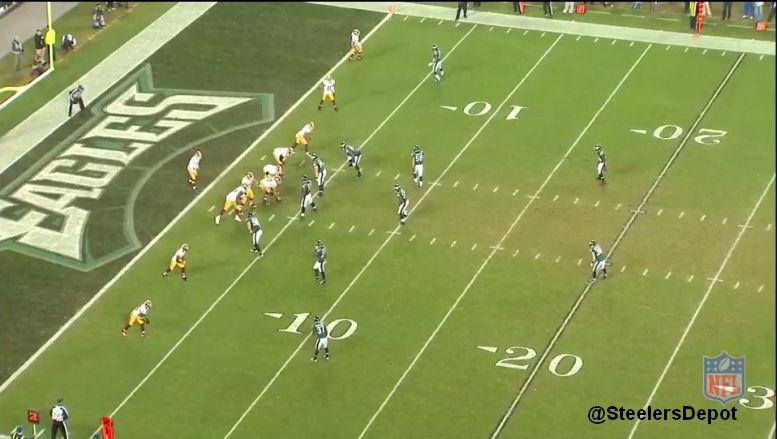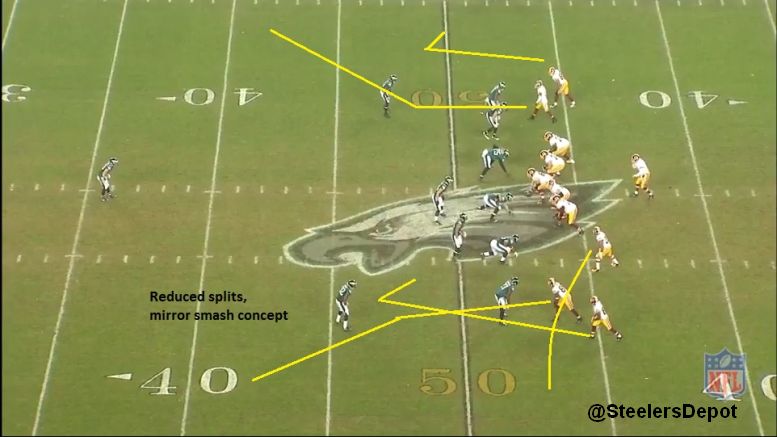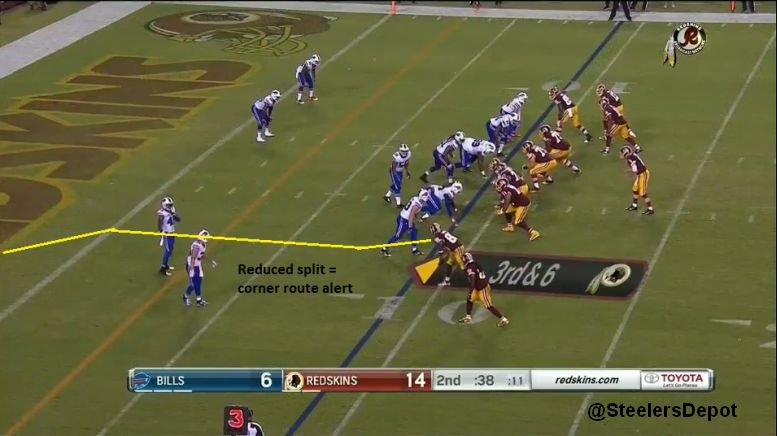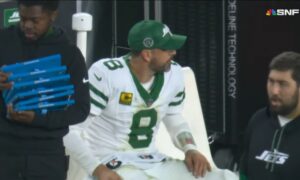This year, Josh Carney and I will break down the opposing team’s offense in our weekly scouting report. You can normally expect these every Friday but with the Monday night game, we waited until today. Like last year, I will be looking at the opposing team in a more broad, scheme-approach. Josh will have a closer eye on the individual players.
Alex’s Scheme Report
Washington’s Run Game
Before getting into their run game, I gotta say, I like their coaching staff. Especially on offense. It’s a consistent bunch with head coach Jay Gruden and OC Sean McVay each in their third year. Bill Callahan is in his second year as the OL coach – he has a highly successful pedigree and has been coaching football since 1980.
It’s a big reunion for Mike Tomlin. Not only did Gruden and Tomlin coach together in Tampa Bay, Ike Hilliard – who spent 2005 with Tomlin – is the team’s receiver coach.
The rushing attack was pretty poor last season. Only 3.7 yards per carry (30th in the NFL) and they fumbled 11 times, the second most in the league. Matt Jones has a history of struggles holding onto the football. The Steelers need to gang tackle and when the first man has Jones wrapped up, someone else should swoop in to rip the ball out.
Last year, Washington had 13 runs of 15+ yards. Three of those were by Jones. Another four by third down back Chris Thompson and the rest by Alfred Morris, who is now in Dallas. Those 13 runs tied for 25th in the NFL. By comparison, the Steelers had 23 and the league leaders, the Buffalo Bills, had 36.
That’s all to say is that the Redskins’ run game was far from where it needed to be last season. Matt Jones will be the starter with impressive UDFA Robert Kelley backing him up. Both are big guys. Jones 231, Kelley 226. Power and power.
It’s reflective of the group they have up front. It’s a hefty front five. Here’s the starting OL’s height and weights, based on what they’re listed at on the team site (not always the most reliable but what we’ll go with).
LT: Trent Williams – 6’5 320
LG: Shawn Lauvao – 6’3 326
C: Kory Lichtensteiger – 6’2 295
RG: Brandon Scherff – 6’5 323
RT: Morgan Moses – 6’6 335
Backup OT Ty Nsekhe is 6’8 335. He was used in some tackle-eligible work last season. And they’re a physical bunch too, especially the combination of Scherff and Moses.
With Gruden as the head coach and you might think they’re strictly a zone blocking team. They’re not. They run everything. Sure, some of that is their zone schemes, inside/outside, but you’ll get a lot of power and man concepts, too.
Here’s an example of one. And again, when you get their double-team with Scherff and Moses, they’re people movers. Tough to stop.
You can see their center is often asked to reach the one tech. Daniel McCullers could get sealed. Javon Hargrave has a much better chance of defeating the block and getting penetration. If you get reached in this situation, you put a ton of stress on the linebackers. Can’t let it happen.
They have a pin and pull run scheme in their playbook, shown here.
One alert I picked up on. 2nd and long with the ball between their 20 and 30, they’ll run a toss play to the perimeter. If the WRs are bunched to a side, that’s where they’re going. If not, they’ll run it to the closed side, away from the receivers. Saw it in different games, including twice against the Philadelphia Eagles.
Washington employed fullback Darrel Young last season. He is no longer on their roster and there is no FB listed. I didn’t see much use of one in the preseason but if they do ever have one, those responsibilities will likely fall on Niles Paul.
Instead, they’ll use some 13 personnel, three tight end sets, and often stack them all to the same side, forcing you to defend several more gaps than defenses typically have to. Instead of say, the A, B, and C gaps, you have to defend the A, B, C, D, E, and F gaps. Think of what Stanford does in college football.
Washington Pass Game
Some quick stats from last year. They averaged a little under 354 total yards per game (run + pass), 17th in the league. They were tied forth 6th in yards per attempt, 7.7. Kirk Cousins was sacked 27 times on roughly 600 dropbacks. Washington was 43.5% on third down, a strong 5th in the NFL. Their home red zone TD percentage ranked 7th in the league and overall, home and away, was 11th.
Looking at strictly the passing game, they were tied for 11th (with a ton of teams) in 20+ yard gains through the air with 53. The Steelers had 61. Reed had the most of those, 14.
In 40+ gains, they ranked tied for 19th with only nine. By comparison, Pittsburgh had 21. Jackson had four of those. Reed didn’t have a single one.
There are two things Washington does really effectively on offense: they spread you out vertically and horizontally. Get guys in one-on-one matchups, utilize the entire width of the field, and get their talent in space.
Based on last year’s tape, Washington loves to empty their formation. Five wide, with Jordan Reed detached and the back split out. Force defenses to declare their coverage – they’ll use motion to identify man/zone – and make them unable to hide their blitzes, or check out of the call entirely. Every team has their checks to empty and the Steelers will have to communicate that effectively, the first game of the year and on the road. We know the struggles the team had in doing so last year against New England, though a year under Keith Butler’s belt is an obvious benefit.
Heck, they’ll go empty set on their own goal line.
The first thing that struck me in the first game I fired up, Week 16 last year against Dallas, was the amount of playaction they used. Even with a pretty ineffective run game, playaction is enough. Linebackers are still going to read their keys and bite against the run.
From the start of the game to early in the second quarter, Washington ran playaction five times. And largely successful plays, too.
Off it, you’ll see their Y or Z over, a Cover 3 killer and a concept that has given the Steelers fits over the years. As soon as you see it in the GIF, you’ll be flooded of memories of big plays given up.
They’re a flexible unit. Lots of different personnel groupings and formations pre-snap, they’ll move players around – you’ll see Desean Jackson in the slot – and they mix in some run/pass options (RPOs) to give Cousins flexibility at the LOS.
Anytime you see receivers with reduced splits, you have to worry about corner (flag) routes. But Washington probably runs more of those than anything. Have to be aware of it against any bunch or 2×2 stack look. Here’s an example.
You’ll notice these routes are mirrored – the same to each side – another element Washington uses with frequency. Their “smash” route, corner/curl, is one of their top concepts. Read the cornerback. If he sinks on the corner (Cover 3), hit the corner or flat defender. If he sits (Cover 2, man coverage), throw the corner.
Especially in the red zone. If the receiver gets leverage on his break down there, it’s game over.
Reed is a unique threat, I believe that’s exactly what Tomlin called him, and he’s often detached from the formation. Not used much as a blocker in the pass game and primarily, Washington uses five man protections. That makes it tougher to blitz, the rush better get home, but it opens up the chance for players to get some serious pressure if they can win their one-on-one matchups. Especially along the interior. Looking at you Cam Heyward, Stephon Tuitt, and Hargrave. Crucial matchups there.
They’ll get Reed down the seam, like you’d expect, but also use him on angle routes, reading the underneath defender and if he sits outside, breaking it back inside.
Washington’s Special Teams
Rashad Ross appears to be the team’s starting punt and kick returner. He served in the latter role last season, averaging 24.4 yards per kick. He had a 101 yard touchdown, too.
Their kick return unit is a 5-2-2-2 look.
Bashaud Breeland and Quinton Dunbar served as the jammers.
Punter Tress Way is the field goal holder. He has never thrown a pass in his NFL career. The Redskins have appeared to have run one fake under Gruden, back in 2014 against the St. Louis Rams. Washington was down 9-0 mid third quarter, facing a 4th and 5 on their own 33. Way ran the football off the right side but was tackled after a gain of just two.
It does not appear he ever attempted a pass or rush in college at Oklahoma.
Josh’s Individual Report:
Last season the Washington Redskins’ offense was a revelation in Year Two under Head Coach Jay Gruden. Although he made a controversial (at the time) decision before the start of the season to name Kirk Cousins the starter over Robert Griffin III, things paid off in the end as the Redskins’ passing game took off in 2015 despite finishing with the 12th-fewest passing attempts in the league.
With Cousins at the helm, Washington finished 10th in points (24.2), 10th in completions (386), first in completion percentage (69.5), 10th in average (7.6) and third in quarterback rating (102.0). Despite the success of Cousins and the passing game, Washington’s rushing attack had an uncharacteristic down year, finishing 14th in rushing attempts per game (26.8), 28th in yards per carry (3.7) and 20th in yards per game (97.9).
Under Gruden, Washington is a pass-first team that emphasizes ball control and quick hitting passes to get the ball out of Cousins’ hands quickly.
As a smart, decisive, accurate passer, Cousins excels in this style of offense, as evidenced by his great run to close last season, leading to the franchise tag this offseason.
Despite emphasizing, quick, safe throws, Cousins does love to drive the deep ball and sideline routes down the field to guys like Pierre Garcon and DeSean Jackson. Now, with the addition of first-round pick Josh Doctson, Cousins has yet another weapon to work with.
It’s pretty simple with this offense as to what role each weapon plays for Washington. With Garcon you have a bonafide possession receiver that is a steady chain-mover, while Jackson is the home run threat that looks to take the top off of opposing defenses, opening up underneath routes for Garcon, tight end Jordan Reed and second-year receiver Jamison Crowder.
Much like Garcon, Crowder really emerged as a dynamic possession receiver last season lining up all over the field and taking advantage of mismatches to move the chains for Gruden and Cousins.
The biggest weapon in this offense though is Reed, whom the Redskins use mostly like a receiver, moving him all around the lineup to get the best matchup possible and get him the ball quickly to create havoc after the catch.
In 14 games last season, Reed had at least 7 catches in a game six times while hauling in at least two touchdowns five times. The duo of Reed and Cousins really clicked down the stretch in 2015 and hit it off again this past preseason as Cousins found Reed for a score in the tight end’s only action of the preseason.
Washington really likes to get Reed working in the middle of the field on crossing routes against linebackers that simply can’t match his speed, so keep an eye out for that Monday night.
One play I saw Washington run a lot for Reed was this one here.
This came against the Buffalo Bills in Week 15 at home last season. Getting Reed moving across the formation allows him to get the edge against the defense that is slow to react. He’s clearly a weapon to keep tabs on at all times, so Washington does what it can to give him space to operate.
Along with Reed, the Redskins added Vernon Davis to the mix his offseason, giving Washington two prototypical move tight ends for Cousins to work with. Splitting last season between San Francisco and Denver, Davis looked lost and a step slow, but if anyone can revive his career and utilize him to the best of his abilities, it’s Gruden.
Although the Redskins’ passing game gets most of the credit for their resurgence last season as the NFC East division champions, what really stood out with the Redskins was the play up front from left tackle Trent Williams, left guard Shawn Lauvao, right guard Brandon Scherff and right tackle Morgan Moses.
Williams was a revelation last season as the former first-round pick out of Oklahoma took a massive step forwards as a pass blocker and run blocker, while Scherff stepped in right away as a rookie and provided the offensive line with a much-needed mean streak.
Lauvao really improved as a run blocker and proved to be the best Washington had in that area, really using his athleticism and great footwork to get to the second level in the zone scheme to open up big cutback lanes for Alfred Morris and Matt Jones.
Washington will need more of the same in 2016 if they want to repeat as division champs. Morris has moved on to the Dallas Cowboys, so the starting running back gig is all Jones’. Injuries are an issue with the second-year back, but that comes with the territory as a punishing runner.
Unlike Morris, Jones isn’t an explosive back, but he’s a one-cut runner that gets downhill fast and looks to bury people at the end of runs. He’ll be a load to deal with Monday night in Washington.
The big knock on Jones (outside of injuries) is his fumbling issues. Last season Jones put the ball on the ground five times, so he’ll need to clean that up as the starter this season.
Behind Jones is rookie running back Robert Kelley out of Tulane, who is very similar to Jones in style (as well as hairstyle).
Chris Thompson returns as the do-everything scat-back that is underutilized in Washington, but that should change in 2016.
On special teams, Washington has had a revolving door at kicker over the last few seasons, but the Redskins have finally seemed to settle on third-year man Dustin Hopkins out of Florida State.
Hopkins went 25-for-28 (39-for-40 XP) in 2015 despite having one field goal attempt blocked. From 40-49 yards last season Hopkins finished 7-for-8 while going 2-for-4 from 50+.
He’s not known for having a booming leg, but Hopkins is a very technical kicker with solid form, which really allows him to drive through balls.
In the punt return game, Washington will rely on Crowder as a punt returner — a role in which the rookie excelled at in 2015, returning 30 punts for an average of 5.3 yards per return. With another year under his belt, Crowder should return to the game-breaking ways as a punter returner.
On kickoffs, Washington is still searching for a consistent threat, having cycled through Crowder, Jackson, Rashad Ross and Thompson, but it appears as though the coaching staff has settled on Ross as the man.
Last season Ross returned a kickoff 101 yards for a score against the New York Giants, Sept. 24. Ross averaged a team-best 24.6 yards per return on kickoffs in 2015.

